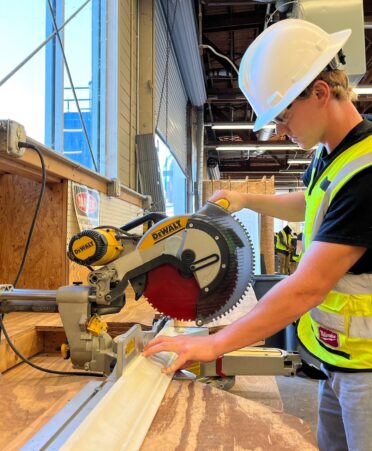(WACO, Texas) – Students in Texas State Technical College’s technical programs are taught early and often about personal protection, which includes hand safety.
“Shortcuts lead to a lot of hand injuries,” said Jason Morrow, an instructor in TSTC’s Occupational Safety and Environmental Compliance program.
According to the U.S. Bureau of Labor Statistics’ Injuries, Illnesses and Fatalities program, there were more than 102,300 nonfatal hand injuries nationwide across all industries in 2020.
Morrow said all industries have moving parts and materials that can create pinch points and places where hands are not supposed to be. He said people should not wear rings and other jewelry due to the injury risk.
“Personal protective equipment (PPE) is not going to save you,” Morrow said. “PPE is the last line of defense.”
The U.S. Occupational Safety and Health Administration gives general guidelines for personal safety, but companies should go beyond that to set policies, said Brian Spry, lead instructor in TSTC’s Occupational Safety and Environmental Compliance program.
Reducing the risk of injuries can keep workers’ compensation claims low and build better safety records, Morrow said.
Construction
Herschel Miller, lead instructor in TSTC’s Building Construction Technology program, said students learn about tool operation and safety in the Construction Technology I class taken during their first semester. Safety is emphasized at the start of every hands-on lab throughout the curriculum.
“We are working with table saws, jigsaws and hammers,” Miller said. “We show them how to hold the nail correctly and how to hammer it.”
He said gloves are normally worn outside when it is cold, but he said they sometimes are cumbersome. He said a risk of wearing gloves is they can slip off and get caught in operating saws. He said guards are installed on all equipment that the students use.
Miller said female and male students need to keep their fingernails cut short to prevent them from being torn off by equipment.
Residential and nonresidential construction had more than 2,500 nonfatal occupational hand injuries in 2020, according to the U.S. Bureau of Labor Statistics.
Among the tools that construction students use are nail guns. According to the Center for Construction Research and Training, the most common nail gun injuries are puncture wounds to the fingers and hands. Accidental firings cause the most injuries.
Hammers can also cause hand injuries.
The International Association of Drilling Contractors recommends that people keep hammer handles and their hands clean. Hammers should be used by gripping the handle’s end, with nails held near the head. People should begin with gentle taps to get into a good hammer rhythm.
Machining
Jeremy Bailey, lead instructor in TSTC’s Precision Machining Technology program, said students complete an online safety module every semester covering hand safety, footwear, and other personal protective equipment.
He said students use their hands to turn knobs and levers while doing manual machining, along with using measuring tools.
“We are so different from a lot of industries in that we don’t wear gloves,” Bailey said. “It’s safer for us not to wear gloves because we are around a bunch of spinning materials and tools. Also, a lot of what we do involves surface finishes, and you have to be able to use your fingers to touch and make sure everything is to the proper finish.”
Machine shops had more than 1,000 nonfatal hand mishaps in 2020, according to the U.S. Bureau of Labor Statistics.
Registration continues for the fall semester at TSTC. For more information, go to tstc.edu.
